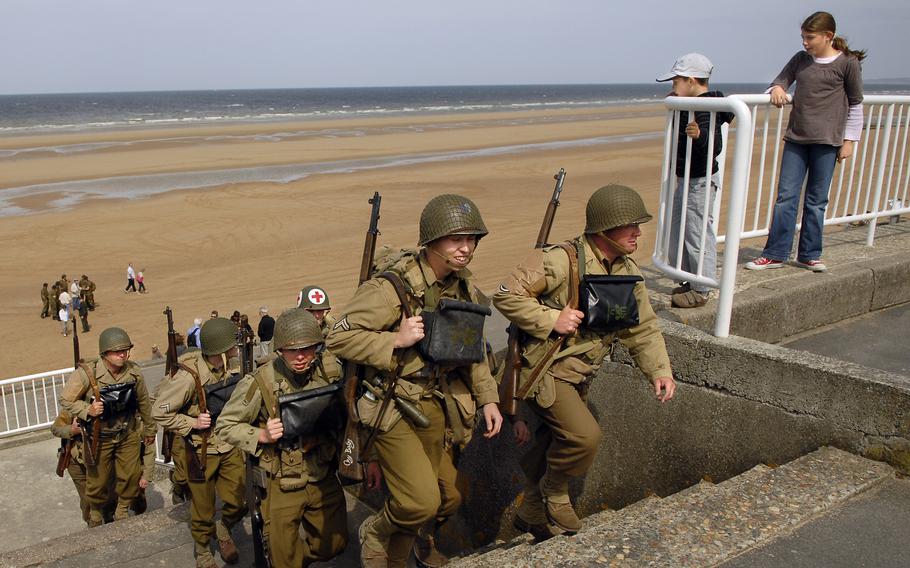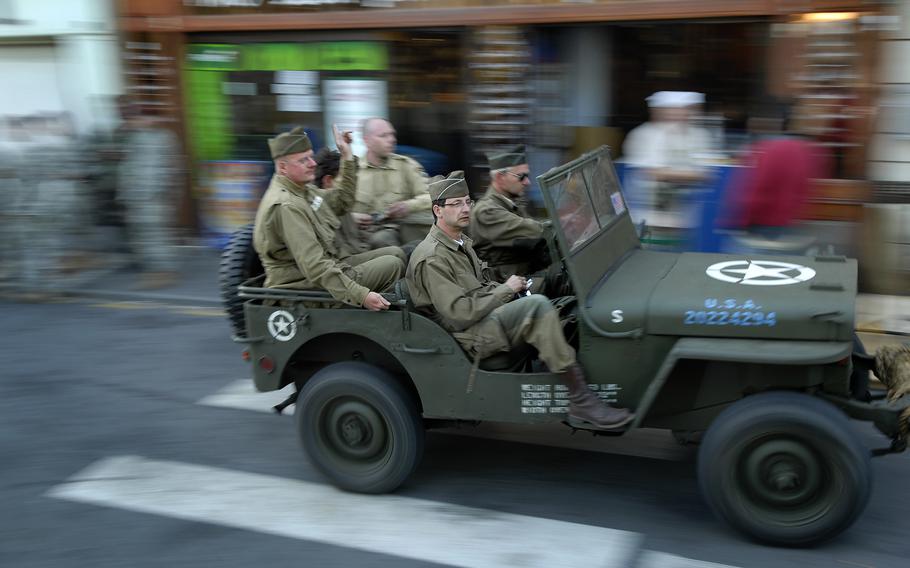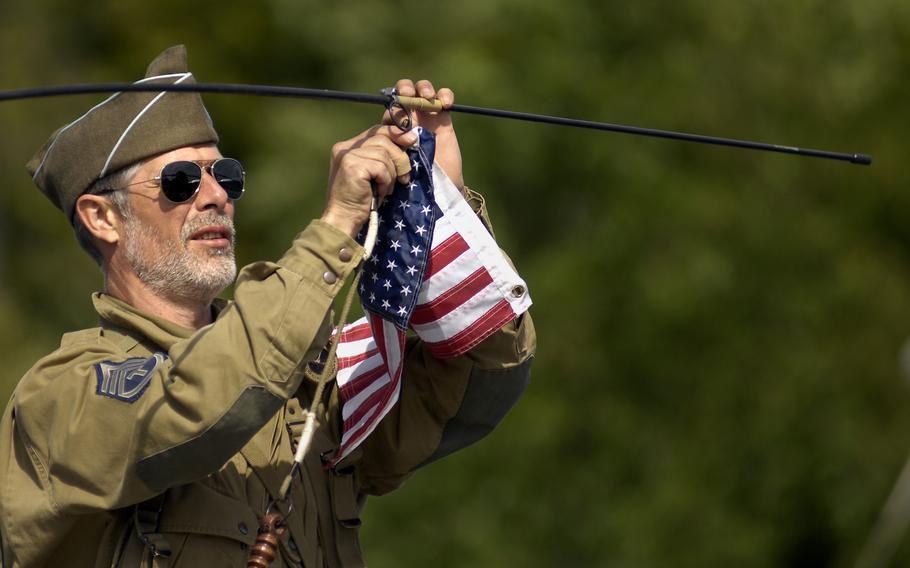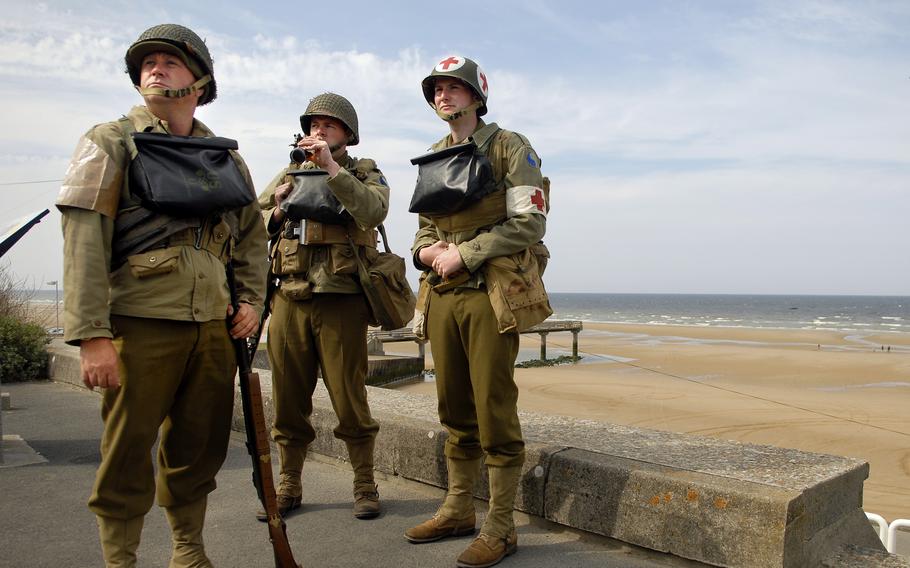
Children watch as re-enactors from southern England climb up from Omaha Beach in Normandy, France. (Ben Bloker/Stars and Stripes)
This article first appeared in the Stars and Stripes Europe edition, June 8, 2009. It is republished unedited in its original form.
SAINTE-MÈRE-ÉGLISE, France — Standing by his Harley at the base of a linden tree, Pete Cuthbertson beamed like a proud papa as a steady stream of soldiers stepped up to fawn over his vintage motorcycle.
Not wanting to cut any historical corners, he outfitted the 1943 military police bike with all the right accessories, from a leather satchel to a fully loaded cloth tool kit. Heck, even the tire nozzle caps were real — steel, not rubber, thank you.
"They take a lot of pride in what they are doing," Sgt. 1st Class Jimmy Cannon, a Green Beret, said as he stood over the Harley 750 WLA.
And it wasn’t just Cuthbertson’s ride that was right with the world either. He wore an authentic World War II uniform, vintage brown boots, a khaki hat and boxer shorts. But more on that last item later.
Cuthbertson came to Normandy, France, this past weekend with a posse of imposters, though nobody seemed to mind their presence. Cannon didn’t care, nor did his colleague, Sgt. Thomas DeMoss.
"It’s honoring the memory of the people before them," DeMoss said of military re-enactors. "They are creating the atmosphere of how it was."

A jeep speeds by the Stop Bar, a popular hangout of active duty troops and re-enactors, June 4, 2009, in Saint-Mere-Eglise, France. Re-enactors from across Europe descended upon the French coastal towns for the 65th anniversary of D-Day. (Ben Bloker/Stars and Stripes)
Military re-enactors are a big part of any World War II commemoration in Europe, particularly those devoted to the United States. But who are these people and what motivates them?
Jenny Thompson has spent more than a decade researching this phenomenon — or hobby, as some call it — for her doctoral thesis in American studies. She went on to write a book on the subject, called "War Games: Inside the World of Twentieth-Century Re-enactors."
"A lot of re-enactors have relatives who fought in a war, especially World War II," Thompson said by phone from her home in Evanston, Ill.
War, she added, "is something they are just fascinated about in general." For a lot of re-enactors, they want to experience the discomfort, hardship and fatigue. They want to steer away from the Hollywood heroics.
Relatives of war veterans typically fall into one of two camps: those with vets willing to talk about their experiences and those whose forebears find them too painful to recount. The talkers often spur further interest, while the silent types leave their relatives wanting, creating "a deep mystery," Thompson said.
Hans Van den Driessche’s father was called to service by the Belgian government in the early days of World War II. But the Germans conquered his country so swiftly that he never had a chance to don a uniform.
Van den Driessche briefly served in the Belgian military when he came of age, but his interest in World War II well predated that. As a boy he played with toy soldiers. As an adult he plays around with grown-up soldiers, visiting re-enactment events and tooling around in one of the two period vehicles or four motorcycles he owns. He always dresses the part, of course.
"The Second World War is my hobby," said Van den Driessche, who has been at it for 21 years. "I like history. I probably have enough uniforms for 50 people."
Thompson said this type of passion and attention to detail is something she experienced when she was researching re-enactors back in the United States, though not all of them are as precise. To understand re-enactors better, she donned uniforms, attended events and took on various roles, such as a prisoner of war or an ambulance driver. The same is true in Europe.

A re-enactor attaches a U.S. flag to the antenna of his jeep June 5, 2009 at the Normandy American Cemetery in France. (Ben Bloker/Stars and Stripes)
Clothes, cars, kits and anything else related to that era are in play. Incredibly, some participants even own World War II planes and tanks. They fight mock battles and willingly endure the hardships associated with the battlefield. A few years back in Bastogne, Belgium, a cadre of re-enactors attending a Battle of the Bulge commemoration in December awoke in the middle of the night to conduct a four-hour foot patrol.
Thompson was at one event where a group had fashioned their own mail. To keep it real, the envelopes had been opened and portions of the letters redacted. Mingling about was a combat correspondent.
"It’s a very interesting group of people," Thompson said. "Some people might think it’s a little odd. [Re-enactors] are more complicated than meets the eye."
She found the demographics captivating. Most are predominately white men, though more women are getting in the mood. The average age is about 38. They tend to be slightly more educated than the mean, and, contrary to conventional wisdom, they come from a wide range of political views.
There are doctors, economists, cops, construction workers, college students. They give new tilt to the "weekend warrior" phrase. Van den Driessche, for example, owns a confectionary business, while Cuthbertson, the re-enactor with the motorcycle in Sainte-Mère-Église’s square, designs and makes furniture.
Cuthbertson’s uniform is authentic "down to his boxers," said Cannon of the 1st Battalion, 10th Special Forces Group in Stuttgart, Germany. "They don’t play around, and the girls fancy them."
The bearer of those old boxer shorts said he was at an event when a female admirer approached him. Cuthbertson said she couldn’t believe his get-up, and was floored when he told her he had authentic underwear on. She asked to see it.
"I told her, ‘You can see it later,’ and she took me up on it," Cuthbertson said with a broad smile. "How many times can a modern girl go back to the 1940s?"

Re-enactors from southern England wait for a ceremony to begin near Omaha Beach June 4, 2009 in Normandy, France. (Ben Bloker/Stars and Stripes)